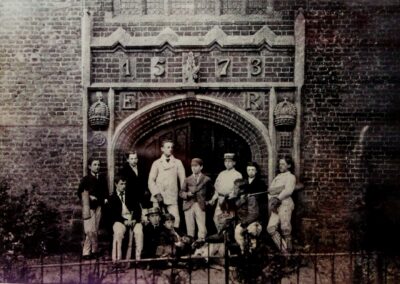
Despite being an official legal document, the charter is adorned with ornate images.
During the 16th Century, printing was limited. There were only 60 printing presses in the country, and they were controlled by the Queen’s privy council. In this way publications and images of the Queen could be censored and only approved material was released. However, to garner support from her subjects, the Queen wanted her approved image to be seen widely. Letters patent offered an opportunity for Queen Elizabeth I to display approved public images of herself. The iconography on the school charter was therefore carefully selected to represent the Queen in a particular way.
Although lacking in detail the sketch of the Queen on the school charter adds authority and legitimacy to the written order. The Queen is depicted seated on her throne wearing a crown and holding an orb and sceptre, indicating her power, status, and divine authority to govern.
The depicted crown is the Imperial crown which signifies a pursuit for empire. Spain had amassed great wealth from the New World and seeing this, Elizabeth I wanted to gain overseas territories of her own. Although, long sea voyages and explorations took place, and several attempts were made at establishing colonies none were successful during Elizabeth I’s reign.

According to the Royal Museums Greenwich, the Imperial crown also refers to the Tudor claim that they were descended from Brutus of Troy who by legend was the descendant of Aeneas and was the mythical founder and first King of Britain. This connection reasserts the Queen’s right to rule.
The Queen holds an orb and sceptre. The orb is a globe with a cross on top, representing Christ’s rule over the world and identifying the Monarch as God’s representative on Earth. The sceptre meanwhile is a symbol of good governance and the power of the crown.

The crown, orb and sceptre all form part of the crown jewels. But these are not the same ones used by King Charles III as the Tudor crown jewels were destroyed by Oliver Cromwell during the English Civil War.
You can also see the Queen wearing an ermine cloak. The use of ermine was restricted to royalty or high nobility and therefore signifies Elizabeth’s royal status. According to legend the ermine, a type of weasel, would rather die than soil its pure white coat and thus the ermine cloak also symbolises the moral purity of Elizabeth. Each black fleck on the cloak is the tip of one ermine’s tail.
Along with the Queen’s image, symbols for England, France, and Ireland, signify her claims to rule these countries.
The central coat of arms shows the shield of Henry IV with England’s three lions quartered with the Fleur-de-lis to represent France. It is surrounded by the motto of the Order of the Garter which translates as ‘Shame on whomsoever would think badly of it.’

Supporting the coat of arms on the left is the Lion of England which represents bravery, valour, strength and royalty whilst supporting the coat of arms on the right is the dragon, symbolising Elizabeth’s supreme power and her triumphs over enemies as well as the Tudor family’s descent from Cadwallader, the last British prince and the first King of Wales (678 A.D.)

|

|
The Fleur-de-lis represents French Royalty and incorporating this symbol on the charter gives legitimacy to the Queen’s claim to the French throne even though her predecessor Mary I lost the last French territory during her reign.

The harp is the symbol of Ireland and was first adopted by King Henry VIII in 1542 when he assumed the position of King of Ireland.

All these symbols together represent a strong and powerful Queen, with the authority and divine right to rule her country. Queen Elizabeth used this authority to grant rights for the foundation of our school in 1573 and the school continues to thrive 450 years later.





